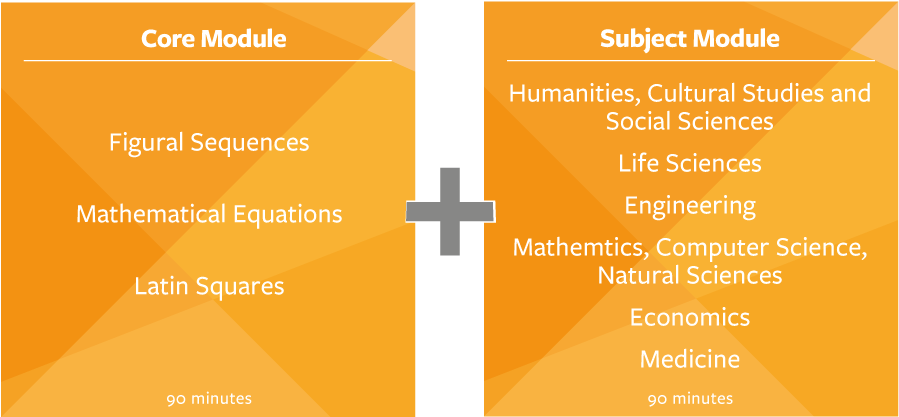
Structure of the digital TestAS
Examination in German or English
The digital TestAS is carried out on computers at licensed TestAS test centres. The test is offered in German and English. Test takers may choose. Only a few universities require TestAS to be taken in a specific language. Please refer to the universities' websites for more information.
Core Module and Subject Module
In the Core Module, you will work on the subtests Figure Sequences, Mathematical Equations and Latin Squares for 25 minutes each (approximately 90 minutes in total, including instructions). Each subtest contains 20 items.
In the Subject Module, you will work on 10 to 15 so-called testlets, each with 4 to 8 associated questions, over a period of 90 minutes.

Figural Sequences
In these tasks, you will see a series of images (matrices). The figures in the matrices can change their position, colour and/or alignment from one matrix to the next in a rule-governed manner. You should continue the series according to the logical pattern.
Mathematical Equations
In this type of task, you are asked to solve systems of equations meeting all constraints. A system of equations always consists of several equations. You are to find out which numbers must be used for the unknowns (letters) in the equations to make the equations fit. There is only one solution for each letter, in which all the constraints are met. Each letter can take a value between 1 and 20.
Latin Squares
In this type of task, you see squares (grids) with 5 rows and 5 columns. Some of the squares in the grid contain letters. The following rules apply to a grid:
- Each letter may only appear once in each row and each column.
- Only the letters A, B, C, D and E may appear in the grid.
Your task is to decide which letter belongs in the place of the question mark. Sometimes you have to fill other cells in your head first.
Subject Modules
A task in the Subject Module (a so-called testlet) uses texts, graphics and tables to describe a topic from a specific subject area. By answering the questions asked about this topic, you demonstrate that you have understood the concept and can apply it to problems.
To be able to work on the tasks in the specialised modules, you should be able to familiarise yourself with the way of thinking and working in the respective subject areas.
In medicine, for example, this includes keeping an overview in texts with many technical terms (however, knowledge of the technical terms is not required to answer questions). In the humanities, cultural studies and social sciences, texts can appear in very different styles and from very different schools of thought. In mathematics, natural science and economics tasks, the ability to interpret diagrams is essential.
In chemistry, dealing with the different forms of chemical compounds is one of the required skills. In computer science tasks, pseudocode can be used. In engineering, more complex technical illustrations and circuit diagrams sometimes have to be understood and physical relationships have to be understood.
For all Subject Modules, comprehension/reproduction of typical forms of presentation (text, table, figure, formula), application and transfer play a vital role. The following tables provide an overview of the topics and contents in the six elective Subject Modules.
Humanities, Cultural Studies and Social Sciences
- Philosophy
- History
- Linguistics
- Literary studies
- Political science
- Sociology
- Methods of social sciences
- Dealing with technical language (knowledge of technical terms is not required)
- Ways of thinking and working in different fields
Life Sciences
- Biology
- (Bio)chemistry
- Physics
- Computer science
- Psychology
- Mathematics and statistics
- Working with formulas and diagrams
- Fundamentals of biology, (bio)chemistry, physics, computer science, mathematics and statistics
Engineering
- Mathematics and Statistics
- Physics
- Chemistry
- Materials
- Technical Mechanics
- Thermodynamics
- Electrical Engineering
- Computer Science
- Development and Construction
- Working with formulas and diagrams
- Basics in mathematics, physics, chemistry and computer science
Mathematics, Computer Science, Natural Sciences
- Mathematics
- Computer Science
- Chemistry
- Physics
- Earth Sciences
- Scientific Work
- Working with formulas and diagrams
- Basics in mathematics, computer science, physics and chemistry
Economics
- Business administration
- Economics
- Mathematics and statistics
- Law
- Information technology
- Working with formulas and diagrams
- Basics of mathematics and computer science
Medicine
- Anatomy
- Physiology
- Biology
- (Bio)chemistry
- Psychology and Sociology for Physicians
- Physics
- Dealing with medical terminology and expressions (technical terms are not assumed)
- Fundamentals of biology, (bio)chemistry and physics
Test preparation and procedure
Before starting the subtests, you will have the opportunity to watch the instructions and an explanatory video.
In the Core Module, you will have two opportunities to take a two-minute break at your desk. After the Core Module, there will be a 30-minute break outside the examination room.
Answers in the digital TestAS are mainly given by selecting one of several options (single-choice format). An exception is the task group Mathematical Equations where answers have to be worked out. Only one answer is correct. The candidates click on the answers on their screen.
Detailed descriptions of the tasks, instructions for taking the test, sample questions and solution descriptions can be found in the document Digital TestAS - Preparation Materials for Participants. If you have registered for the digital TestAS, you may also access a demo version of the test in the test taker portal.
Prepare well for the digital TestAS by using our practice material and finding out how the exam is conducted.
Preparation for the digital TestAS
